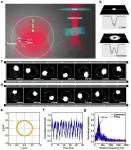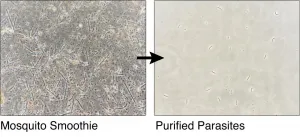Detoxifiers from the landfill
Chemical contamination
2021-06-17
(Press-News.org) The production of chemicals is a cumbersome business. Often, only a small part of what is actually wanted is produced in the factory. The large remainder is unusable - or even worse. Examples? The defoliant "Agent Orange" used by the US army in the Vietnam War was produced in great hurry. It contained dioxin as an impurity. As a result, not only did trees in the combat zone lose their foliage, but US soldiers and Vietnamese civilians also fell ill with cancer years later.
There are also examples from agriculture: In the production of the insecticide lindane, a hexachlorocyclohexane (HCH), only less than 15 percent of the desired substance is produced; 85 percent of the reaction broth is hazardous waste. In the 1950s, this toxic mixture was still sprayed in its entirety on fields and orchards. Later on the effective lindane was separated and sold pure, the rest being dumped in landfills. There the chemicals often still lie today. Lindane has been banned in the EU since 2007, and it has not been used in Switzerland for some time.
The flame retardant hexabromocyclodecane (HBCD) is also a mixture of several substances. It was invented in the 1970s, produced on a scale of several 10,000 tons per year and used in polystyrene insulation boards for house facades, in textiles and in plastics for electrical appliances. It has been banned worldwide since 2014. In Switzerland, plastic containing HBCD is not recycled, but must be destroyed in waste incineration.
Internationally outlawed
Since 2004, the Stockholm Convention on Persistent Organic Pollutants has regulated the handling of such long-lived environmental toxins. Switzerland ratified the agreement in 2003, but all these substances are already in the environment - and finely distributed. HBCD is found in sewage sludge, in fish, in air, water and soil. In 2004, the World Wildlife Fund (WWF) took blood samples from eleven European environment ministers and three health ministers and detected HBCD and lindane in the blood of every single one of them.
Bacteria, the rescuers from the soil
It begs the question: Can we recapture or detoxify the chemical waste of past generations? Fortunately, scientists aren't shying away from icky places in their search for solutions. In 1991, they discovered three strains of bacteria that could consume lindane and its useless chemical siblings in chemical waste sites in France, Japan and India almost simultaneously: Sphingobium francense, Sphingobium japonicum and Sphingobium indicum. Could these bio-cleaners perhaps also digest the flame retardant HBCD and other toxins?
Empa chemist Norbert Heeb and Eawag microbiologist Hans-Peter Kohler, together with researchers from the Zurich University of Applied Sciences (ZHAW) and two Indian institutes, put them to the test. They modified the genes of the Indian bacteria and produced HCH-degrading enzymes in pure form. An enzyme is a protein molecule, a bio-catalyst so to speak, with which bacteria, but also other living cells, can build up or break down chemical substances. The pollutant molecule HCH inserts itself into the enzyme like a key into a lock. Then part of the molecule is split off. The now harmless fragments are released again, and the enzyme is ready to take up the next pollutant molecule.
Mutations open up opportunities
Together with undergraduate student Jasmin Hubeli, Heeb investigated not only the enzyme variants found in landfills, but also an enzyme obtained from a genetically modified bacterial strain. Here, the researchers had deliberately enlarged the "keyhole" so that the larger HBCD molecules could be broken down more easily. The result: The genetic modification influenced the rate, at which the pollutant was broken down.
Empa researcher Heeb is hopeful about their results: "This means that we now actually have a chance to use biological methods to render harmless these long-lived toxins produced by mankind and distributed over large areas." There is still a long way to go, however. The lock-and-key principle of helpful enzymes still needs to be figured out in more detail before tailor-made enzymes for chemical toxins are available in the future.
INFORMATION:
[Attachments] See images for this press release:

ELSE PRESS RELEASES FROM THIS DATE:
2021-06-17
As a new member of photovoltaic family, antimony trisulfide (Sb2S3) has the satisfactory bandgap of 1.7eV, benefiting the fabrication of the top absorber layer of tandem solar cells. Due to special quasi-one-dimensional structure, it shows advantages of less dangling bonds. Based on these advantages, the vacancy defects upon the surface causing the recombination of the carriers could be reduced sharply, which helps to solve the photovoltaic problems in solar cells.
In the previous studies, the relationships between conformation, chemical composition and ...
2021-06-17
Scientists have developed a new method that improves dispensing of viscoelastic fluids - a vital process for circuit board production, 3D printing and other industrial applications
Viscoelastic fluids are difficult to dispense as liquid bridges that form between the substrate and nozzle must be broken
New research has found that twisting these liquid bridges breaks them in a quicker and cleaner way than the conventional method of stretching them
Researchers used high speed imaging to observe that when twisted, a crack forms at the edge of the liquid bridge and propagates towards the center
The underlying mechanism that breaks the liquid bridge was found to be "edge fracture" and is the first time that ...
2021-06-17
During flock encounters, a single vocal interaction seems to be sufficient for making the decision of whether to recruit an individual or flock. Parrots are known for their splendid ability to imitate, including the contact calls of other individuals during vocal interactions. Such rapid vocal matching is hypothesised to precede and mediate the formation of new flocks. But how are such interactions perceived by others?
Heidi M. Thomsen, first author and PhD student at the Department of Biology, University of Copenhagen explains:
-"By using a novel experimental design, we were able ...
2021-06-17
Seiichi Shirai (1905-1983) was an influential architect whose work has affected the designs of significant architects of the 20th century. Associate Professor Kosuke Hato of the Department of Architecture, Faculty of Engineering, Shinshu University has studied the work of Shirai and examined why the architect worked extensively on calligraphy. Hato's strategy is to clarify the relationship between the architect and his activity of calligraphy through Shirai's Theory of Tradition.
The 1950s in Japan is known as a time when architects actively discussed traditions, and Shirai is a representative example. Hato, in his past article, clarified not only the ...
2021-06-17
Is it possible to drive nanoparticles to orbit below the light diffraction limit using a Gaussian beam? A recent joint research project reported in Nature Communications says yes.
It is well known that light possesses not only energy but also momentum. When light irradiates an object, momentum is transferred to the object, thus generating light pressure on the object. At the microscopic scale, microparticles and nanoparticles (such as biocells and macromolecules) can be manipulated by the light force. Atoms can be cooled by light pressure to achieve atomic clocks, Bose-Einstein condensation, and so on.
In addition to the linear momentum of light being transferable, the angular momentum of light can also be transferred to an object, thus causing object rotation. Since ...
2021-06-17
Tissue-engineering scaffolds built around ultrashort peptides provide a new platform for studying bone regeneration in the lab.
The peptides developed at KAUST self-assemble into a cartilage-like hydrogel that mimics the natural matrix that underpins bone formation in the body. Its physiologically relevant properties enable this cell-friendly biomaterial to support the growth and development of bone marrow precursor cells. It also enables tubular blood vessels to take shape, which is a critical part of bone health and repair.
"Our system is a simple, efficient and robust model that closely resembles the complex architecture of native bone tissue," says Ph.D. student Salwa Alshehri. "Using these peptide-based ...
2021-06-17
Thousands of years ago, archaic humans such as Neanderthals and Denisovans went extinct. But before that, they interbred with the ancestors of present-day humans, who still to this day carry genetic mutations from the extinct species.
Over 40 percent of the Neanderthal genome is thought to have survived in different present-day humans of non-African descent, but spread out so that any individual genome is only composed of up to two percent Neanderthal material. Some human populations also carry genetic material from Denisovans - a mysterious group of archaic humans that may have lived in Eastern Eurasia and Oceania ...
2021-06-17
A study carried out by the Institute of Environmental Science and Technology of the Universitat Autònoma de Barcelona (ICTA-UAB) and the Instituto de Saúde Pública of the University of Porto (ISPUP), concludes that exposure to natural spaces during the first COVID-19 lockdown in 2020 was beneficial for the mental health of Spanish and Portuguese citizens.
The research shows that, in Portugal, during the first confinement, people who maintained or increased contact with natural public spaces, such as parks and coastal areas, or who could contemplate these spaces from their homes, presented lower levels of stress, psychological distress and psychosomatic symptoms.
In Spain, those who maintained or increased contact with private natural ...
2021-06-17
"Boomers" and "millennials" who go to church are more likely to trust their neighbours and donate to charity, according to a new study.
Religious beliefs and participation help close the gaps in civic participation between millennials and their elders, researchers have found.
Experts have measured the social "capital" religion gives people of all ages. They found those in their 20s and 30s were less likely to join groups and associations, and less likely to be religious, but being involved with the church gave them more "religious capital" than older people who also attended services.
The study shows boomers often have more social capital than millennials and are more likely to be religious. Religious ...
2021-06-17
A faster method for collecting pure malaria parasites from infected mosquitos could accelerate the development of new, more potent malaria vaccines.
The new method, developed by a team of researchers led by Imperial College London, enables more parasites to be isolated rapidly with fewer contaminants, which could simultaneously increase both the scalability and efficacy of malaria vaccines.
The parasite that causes malaria is becoming increasingly resistant to antimalarial drugs, with the mosquitoes that transmit the disease also increasingly resistant to pesticides. This has created an urgent need for new ways to fight malaria, which is the world's third-most deadly disease in under-fives, with a child dying from malaria every two minutes.
Existing ...
LAST 30 PRESS RELEASES:
[Press-News.org] Detoxifiers from the landfill
Chemical contamination



